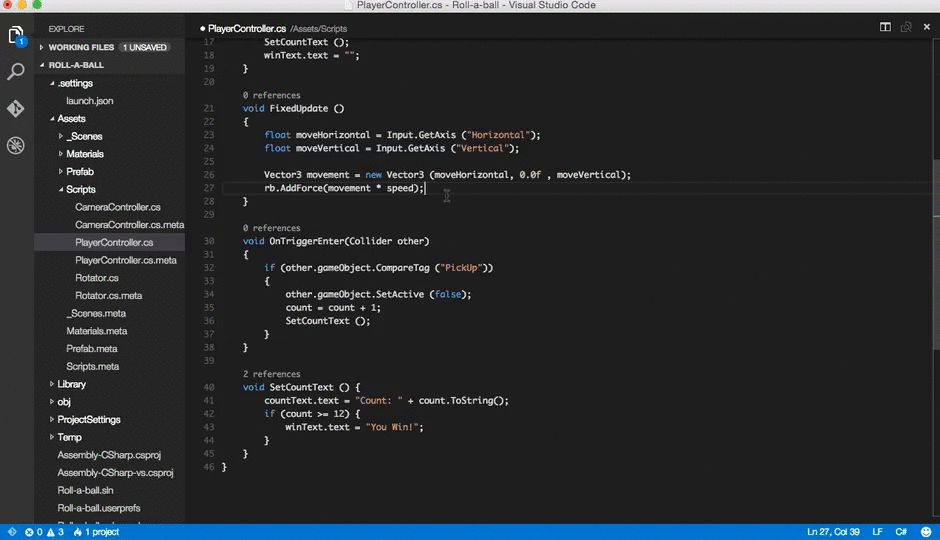The app was coming from another Mac. The second time, the executable file inside the Contents/MacOS subfolder of the app was not. The app was coming from a Windows Unity. A 'chmod 755' on the problematic file or folder, using a terminal, may resolve your problem. Run System File Checker. System File Checker can repair missing or corrupted system files, and therefore solve the missing.dll file problem. It is a quick and easy method. Open Windows search and type CMD. Right-click the Command Prompt result and choose Run as Administrator. In UAC, choose Yes. I already have Unity installed and working, but all I'm trying to do is add ability to run my games on an Android device (I have Android SDK configured and working from my previous Android App development) I'm running the pkg file that I got from Unity called UnitySetup-Android-Support-for-Editor-5.6.1f1.pkg and go through the installation. Enable the Mac App Store Validation setting, then build your app (File Build Settings Build). Next, you need to create a GAMENAME.entitlements file and save it in any location. The easiest way to do this is to create an empty Mac app. Fantasy Grounds is a popular system for playing a host of different roleplaying games online. It is used by more than gamers worldwide to connect and play popular games such as Dungeons and Dragons, Pathfinder, Starfinder, Vampire the Masquerade, Savage Worlds, Call of Cthulhu, and more.
Submitting a Unity3d game to the Mac App Store is a somewhat painful process. This guide refers to Unity3d 3.5 but should apply to Unity 4.0 and up.
Building
First, build your application for Mac and make sure that you uncheck Mac App Store Validation in the PlayerSettings Inspector window.
Building your App from Unity will create a .App file. Navigate to this file in Finder and right-click. Choose Show Package Contents from the context menu to open your app as a folder.
Info.plist
Navigate to the Contents directory and open the file Info.plist in your favorite text editor. You will need to make a few changes to this file.
Specifically, you will need to edit the following entries to correspond to your specific application.
The end result will look something like this:

You can get more information about these keys from the Apple developer documentation. The most notable key in need of changing is the LSApplicationCategoryType which must correspond to an actual category on the Mac App Store. You can find the LS keys documentation here.
Icons

You will need to generate an iconset matching Apple’s Human Interface Guidelines. The first step is to create all of the required icons. You will need variations of your icon supporting the following resolutions.
Unity Mac Build Support
Place all of these icons in the same folder called icons.iconset. Now we have to drop in to Terminal and run the iconutil program to create your icns file which will be named the same as your icons folder. Running

will generate a file called icons.icns. You will need to replace the file UnityPlayer.icns with this icon file using Finder. The UnityPlayer.icns file is located in Contents -> Resources within your .App.
Entitlements

All Apps on the Mac App Store must be sandboxed. To sandbox your Unity app you have to provide an entitlements file to use during the code signing process. A fairly minimal entitlements file should look something like this.
You can read more about entitlements at the Entitlement Key Reference. Tracing program for mac osx.
Code Signing
Now that we have our iconset and entitlements ready we can codesign our App for delivery to the Mac App Store. We have to drop back to the Terminal to run the codesign application.
You can find “XXXX” in the Keychain Access program. Look for a code signing certificate beginning with the text “3rd Party Mac Developer Application” you will need to copy this entire text to the codesign command above. You can find more details from the App Store Submission documentation.
Sequel pro for mac os. Sequel Pro is a fast, easy-to-use Mac database management application for working with MySQL databases. Perfect Web Development Companion Whether you are a Mac Web Developer, Programmer or Software Developer your workflow will be streamlined with a native Mac OS X Application!
In addition to signing your app you must sign libmono.dylib.
If you don’t have the required Keychain Access certificates you will need to create these using the Apple Member Center.
Product Building
To build your final product run productbuild from the command line.
Where “XXXX” is again from Keychain Access. This time, use the certificate beginning with “3rd Party Mac Developer Installer”.
Application Loader
You are finally ready to submit your App! Before submission you must create your App on iTunes Connect and fill out detailed app information. After your app is created launch Application Loader and click on Deliver Your App. Choose the application you created in iTunes Connect from the drop down menu and follow the prompts to choose your .pkg file that was created with the productbuild command.
Unity Mac Build
Your done! Click submit and, if all went well, you will see your app will be delivered to the App Store and be ready for review.
Unity Mac Build On Windows
See also

/apk-file-4152929-12b74d6fa5d7407a8067c1f528493d4d.png)